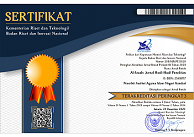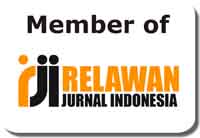HEDOLE DOLE : STUNTING TRADISIONAL MASYARAKAT WAKATOBI
Abstract
Every civilization has knowledge about health. From the beginning until now the most vulnerable groups in terms of health are toddlers and pregnant women. In the Wakatobi community, the health of children or toddlers is also an important aspect that is a priority of the local government to improve the quality of children's lives. In an effort to improve the quality of life for toddlers, the Wakatobi community has a culture as a traditional stunting that has been growing and developing in the community. This study used an ethnographic approach, so the data collection of data analysis uses ethnographic principles. This approach was expected to reveal how the Wakatobi community views health and quality of life for toddlers. The results of this study indicated that the Wakatobi community has had a traditional earrings concept called the Hedole Dole. Through the Hedole Dole ritual, toddlers have special treatment from a sando or traditional birth attendant. After experiencing the Dole Dole ritual, Wakatobi children possessed strong endurance. They will have strong endurance to fight various weather changes. Wakatobi believes and believes that this tradition has improved the quality of life and endurance of their toddlers. They also assume that healthy children are children who have a healthy body and mind. Wakatobi people think that through the ritual tradition of Dole Dole food can have a strong immune system. The process of their idols will be given various types of herbs and treatments that make their bodies stronger and resistant to various diseases.
Keywords
Full Text:
PDFReferences
Anderson, Elizabeth T. communityas Partner: theory and practice in nursing, terjemahan: Buku Ajar: Keperawatan komunitas teori dan praktek dialih bahasakan oleh Agus Suratna DKK. Jakarta: Buku Kedokteran EGC, 2001.
Anhu, L. O. A. (2014). Perkembangan Otak Anak Usia Dini. SHAUTUT TARBIYAH, 30(XX), 98-113.
Creswell, J. W. Reseach Design: Pendekatan Kualitatif, Kuantitatif, dan Mixed. Yogyakarta: Pustaka pelajar. 2012.
Effendy, Nasrul. Dasar-Dasar Keperawatan Kesehatan Masyarakat. Jakarta: Buku Kedokteran EGC. 1998
Helman, C. Culture, health, and illness: an introduction for health professional. Boston, MA: Wright. 1984
Kleinman, A. Patients and healers in the context of culture. Bekeley, CA: University of California Press. 1980
Manuaba, Ida Ayu Chandranita, Dkk. Memahami Kesehatan Reproduksi Wanita. Jakarta: Buku Kedokteran AGC. 2009
Mubarak, Wahit Iqbal dan Nurul Chayatin. Buku Ajar: Kebutuhan Dasar Manusia Teori dan Aplikasi dalam Praktik. Jakarta: Buku Kedokteran EGC. 2007.
McManus, M. Services To Minority Population: What Does It mean to be a culturally competent professional. Focal Point: The Buletin of the research and training center to improve services for seriously emotional handicapped children and their families. 1-17. 1988
Wood, J.B. Communicating With Older Adults In Health Care Setting: Cultural And Etcnic Consideration. Educational gerontology, 15. 351-362. 1989
DOI: http://dx.doi.org/10.31332/ai.v14i2.1508
Copyright (c) 2019 Al-Izzah: Jurnal Hasil-Hasil Penelitian

This work is licensed under a Creative Commons Attribution-NonCommercial-ShareAlike 4.0 International License.










